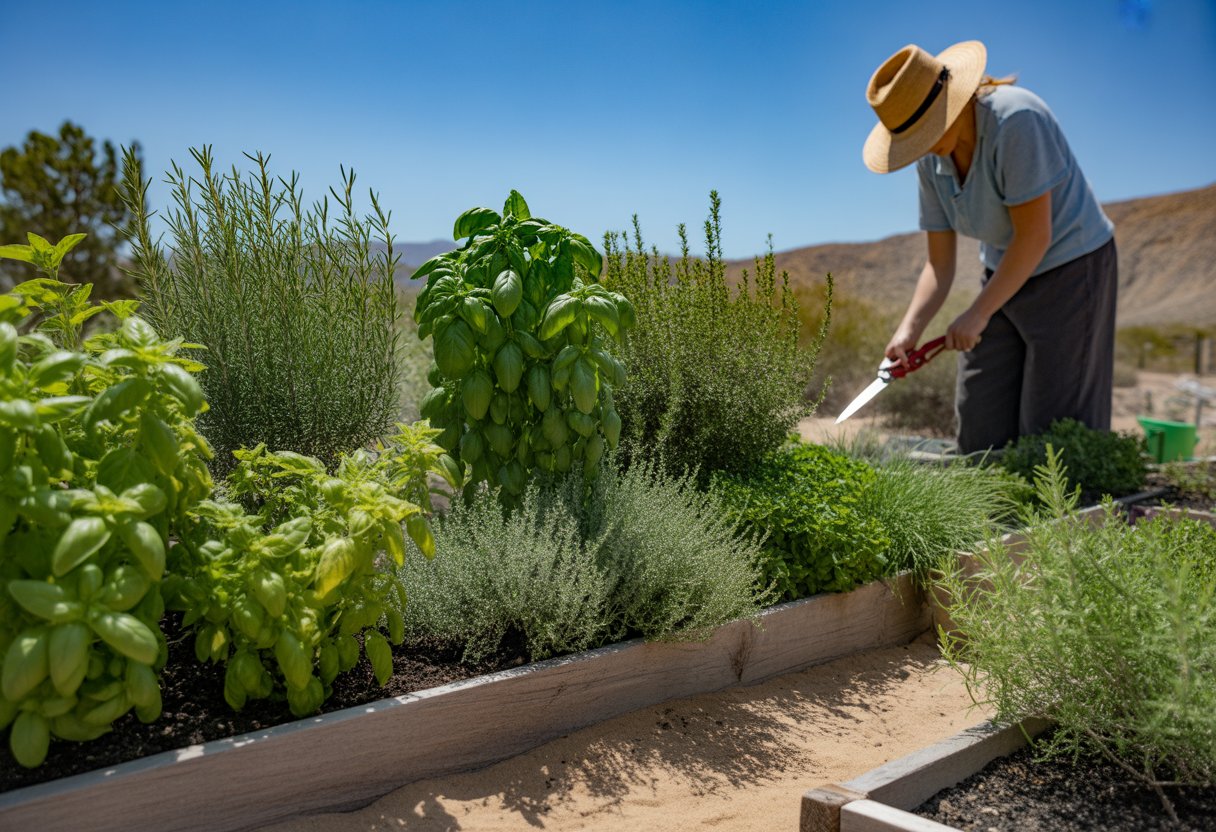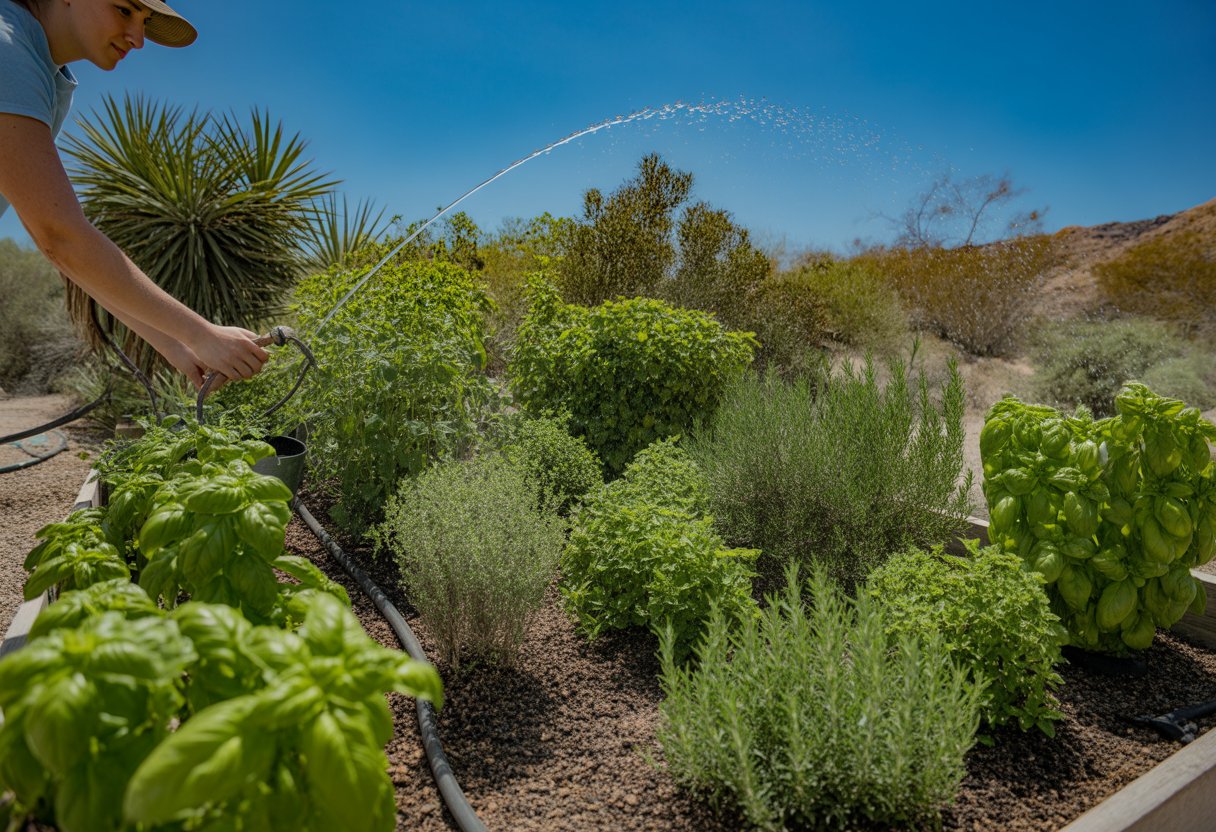Herb Gardening Tips for Nevada: Expert Strategies for Thriving Herbs in Arid Climates
Growing herbs in Nevada? You’ll need to adapt to the dry climate and that relentless sun. Gardeners here have to pay extra attention to soil quality, water management, and picking herbs that can handle tough, arid conditions.
The real trick to herb gardening in Nevada is choosing drought-tolerant varieties and watering smart, not just often.

If you get to know the local environment, you’ll dodge mistakes like overwatering or planting herbs that just can’t hack the heat. With a thoughtful approach, anyone can grow a solid herb garden—even in Nevada’s challenging weather.
Let’s get into some hands-on tips for prepping soil, watering right, and picking herbs that actually want to grow here.
Essential Herb Gardening Tips for Nevada
Nevada’s dry climate and wild temperature swings make herb gardening a bit of a puzzle. You’ve got to think about soil, water, and which plants can really handle the stress.
Understanding Nevada’s Climate and Hardiness Zones
Nevada ranges across USDA hardiness zones 5 to 9, and that depends a lot on elevation. Down in the low desert, summers get brutal—100°F is nothing unusual. Higher up, you’ll find cooler weather and a shorter growing season.
Low humidity and barely any rain mean water conservation is a must. Frost can sneak up early or late, so timing your planting is key if you want to avoid cold shock.
It helps to notice your yard’s microclimates—maybe a spot gets afternoon shade or is protected from wind. That can make all the difference.
Selecting the Best Herbs for Local Conditions
Some herbs just love heat and dry soil, so they’re perfect for Nevada. Think rosemary, thyme, sage, oregano, and lavender. These Mediterranean herbs are basically built for arid places and don’t need constant watering.
Basil and cilantro? They’re a little fussier. Give them more water and maybe some afternoon shade, or treat them as annuals.
Going for drought-resistant varieties really boosts your odds. If you want less hassle, try native herbs like desert lavender or hyssop.
Adapting Gardening Techniques for Success
Raised beds or containers work wonders here, since Nevada’s soils are often sandy and alkaline. You’ll get better drainage and way more control.
Mix in organic matter to help the soil hold moisture and feed your plants. Mulch is your friend—it keeps water from evaporating and evens out the soil temperature.
Drip irrigation targets the roots and saves water. If a heatwave hits, some shade cloth can shield your herbs from frying. Don’t skip pruning; it keeps air moving and cuts down on disease.
Soil Preparation and Drainage Strategies
Getting the soil right is half the battle in Nevada. Good drainage and the right amendments help herbs soak up moisture and nutrients—without drowning their roots.
Choosing Quality Potting Soil
Start with quality potting soil. Look for something light, fluffy, and quick to drain but still holds some moisture. Clay-heavy or compacted mixes just choke the roots and invite rot.
A solid Nevada mix usually has peat moss, perlite, and vermiculite. These ingredients keep things airy and manage water well. Skip garden soil or topsoil alone—they get dense and don’t drain.
Optimizing Drainage for Desert Conditions
Drainage is everything here. Use containers with lots of drainage holes, or raise your beds so water doesn’t pool.
Mix in sand or small gravel to boost porosity. That mimics the desert and keeps roots from staying soggy. Mulch with chunky material to slow evaporation but let water escape. Check the soil often so you’re not watering too much or too little.
Amending Soil for Nutrient-Rich Growth
Nevada soils just don’t have much organic matter. Work in organic amendments like compost, aged manure, or worm castings to boost nutrients and help the soil hold water.
Here’s a typical amendment mix:
| Amendment | Purpose | Application Rate |
|---|---|---|
| Compost | Adds nutrients and moisture | 25-30% of potting mix |
| Perlite/Sand | Improves drainage | 10-20% mixed into soil |
| Aged Manure | Provides slow-release nutrients | 10-15% incorporated |
Top off these amendments each season so your soil stays fertile as your herbs grow.
Planting and Caring for Popular Herbs

Herbs that thrive in Nevada need the right soil, watering, and sunlight. Mediterranean types handle heat and drought, but others want regular water and maybe some shade. A little care goes a long way for fresh herbs at your fingertips.
Growing Oregano, Thyme, and Rosemary
Oregano, thyme, and rosemary love full sun and soil that drains fast. In Nevada, they do best in sandy or loamy soil with a slightly alkaline pH.
Water these herbs deeply but not often—think Mediterranean, not rainforest. Too much water will rot the roots. Prune them in early spring to encourage bushy growth.
Rosemary can get big and woody, so don’t be shy about trimming it back. Thyme spreads out and can double as ground cover. Oregano grows fast; you might need to rein it in so it doesn’t take over. Mulch with small rocks to keep roots cool and trap moisture.
Cultivating Basil, Sage, and Chives
Basil, sage, and chives want more consistent moisture than the tougher Mediterranean herbs, but the soil still needs to drain well. Basil likes rich soil and full sun, but it wilts fast if you let it dry out.
Sage handles dryness but grows better with moderate watering. It appreciates full sun and a little pruning to stay bushy.
Chives do fine in full sun or partial shade. They like moist soil and can handle a missed watering now and then, but you’ll get more growth if you water weekly. To harvest, just snip leaves near the base and they’ll bounce back.
Maintaining Parsley and Fresh Culinary Herbs
Parsley needs some afternoon shade during Nevada’s hottest days or it’ll scorch. Keep the soil moist and loaded with organic matter.
Fresh herbs like mint and cilantro need careful watering to avoid root rot. Raised beds or containers help with drainage. Harvest often to keep new growth coming and your plants healthy.
A simple watering routine and the right amount of sun—tailored to each herb—make all the difference for flavor and vigor.
Watering, Irrigation, and Planting Schedules

Watering in Nevada isn’t one-size-fits-all. The needs shift depending on which herbs you’re growing and the weather. Tweaking irrigation and planting times to fit the local climate saves water and keeps your garden happy.
Establishing Effective Irrigation Systems
Drip irrigation works best for Nevada herb gardens. It gets water right to the roots and keeps evaporation low. Soaker hoses or drip emitters under mulch hold in moisture even longer.
Timers and moisture sensors can take the guesswork out and keep watering consistent. Water early in the morning so plants soak it up before the heat sets in.
Skip overhead sprinklers—they waste water and can spread disease. For lettuce and delicate herbs, use drip lines to keep leaves dry but soil moist.
Scheduling Planting for Optimal Yields
Nevada’s growing season is short and hot, so timing is everything. Cool-season crops like lettuce and broccoli go in early spring or late fall to avoid heat waves.
Start warm-season crops, like roma tomatoes and peppers, inside or buy seedlings. Move them outside after the last frost, usually around mid-April in most of Nevada.
Stagger your plantings—lettuce every 2-3 weeks, for example—to keep the harvest coming. Onions go in early spring and finish before summer gets too intense.
Adapting for Tomatoes, Peppers, and Companion Plants
Tomatoes and peppers like steady moisture and soil that drains well. If you water deeply but not too often, their roots tend to grow stronger.
Try irrigating about two or three times a week, but watch the weather—hotter days might call for more. Planting basil or onions nearby can help keep some pests away.
Some gardeners swear basil makes roma tomatoes taste better, and it might even help with bugs. Mulch helps hold in water and keeps the soil temperature steady.
If you sync up the planting times for tomatoes, peppers, and their companions, you’ll probably use water more efficiently. It’s all about making the most of what’s there.


